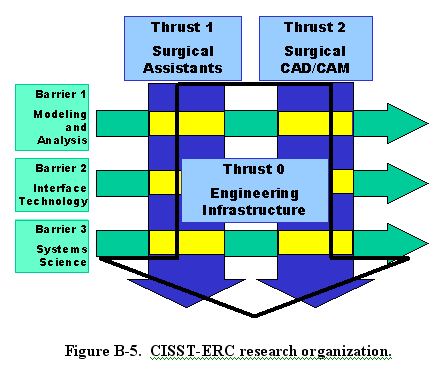The “systems evolution” depicted in Figure B-2 has demanded a set of deliberate strategic changes in our entire center, most of which took place in Years 4 and 5. These changes involved the termination of an entire thrust (The original Thrust 3), the redefinition of our clinical focus and testbed milestones in Thrust 1, a strengthened focus on common CIS architectures in both thrusts, the creation of new research activities, and the termination of certain research activities because of completion or lack of relevance or productivity. To recognize the importance of underyling common CIS subsystems, last year we declared a new thrust (Thrust 0), Infrastructure, which is led by Dr. Peter Kazanzides, who was hired specifically to lead this thrust.
Our thrusts are not separate activities. Instead, as illustrated in Figure B-5, Thrust 0 is an R&D program that cuts across both Thrusts 1 and 2. Thrust 0 supports Thrust 1 and 2 in the implementation of specific systems, as well as being actively engaged in the definition of the next generation of CIS systems. Thrust 0 is an important arm in “hardening” our systems for both clinical adoption and commercial marketing.
The relationship between our thrusts and research barriers are also revealed in Figure B-5. Research takes place at the intersections between the “rows” and “columns” of this matrix. Fundamental research involving Barriers 1 and 2 – modeling and analysis and interface technology – primarily interacts with driving clinical applications in Thrusts 1 and 2, while research in Barrier 3 – systems science – interacts with all three thrusts.

Our research, although spanning the strategic plan from basic to applied research, is directed toward validation (proof-of-concept) within specific surgical scenarios, sometimes even for particular surgeries. In selecting specific surgical scenarios/testbeds, we apply several criteria:
- Clinician involvement. This begins with the formation of a surgeon-researcher-engineer team. Fortunately, the CISST-ERC is associated with world-class medical institutions and our clinical collaborators have been strong and active supporters of our efforts.
- Clinical importance of the proposed surgical application. We evaluate whether the procedure or condition to be treated is prevalent in the population, whether the “leverage” offered by the system’s capabilities over existing techniques is substantial, and whether there are potentially significant cost/quality impacts on clinical outcomes?
- The project’s synergy with development of novel therapies. For example, there is widespread clinical research focused on development of localized therapy for cancer that requires the ability to integrate optimized dose planning and accurate delivery of patterns of localized treatments, such as radiation seeds, RF or laser ablation, or injected drugs.
- Technical suitability. This is important for targeting of novel capabilities that are sufficiently difficult to require significant advances in basic knowledge and technology, but not impossible.
- Availability of suitable infrastructure and “critical mass” to support the proposed application. In addition to clinician input, such factors include available imaging environments and databases, related research that can be leveraged, the potential for supplemental funding, and the interest of key researchers.
- Industry interest. The center looks for projects that build upon ERC core strengths and are of interest to our industrial affiliates in order to promote collaborative work with them.
Overall research direction is then provided by the surgical scenarios on which we have chosen to concentrate. The research barriers to these scenarios must then be addressed, and projects funded according to priority. Researchers closest to the application have generally identified the technical barriers that must be addressed, and broad discussion during our planning cycle has led to detailed project planning in order to accomplish our overall goals. Funding priorities are ultimately set by the ERC Leadership and decisions to start new core-funded projects, continue funding, or de-fund projects are made every year. The allocation of our resources – including faculty, students, post-docs, and dollars – is set forth in table 2. It shows significant growth in funding, particularly in thrust 1 and the newly created tasks 1.4 and 0.1. We have been very successful in acquiring non-core funds to support projects within our strategy. This is a strong indication of the strength of our investigators and success of our strategic planning process.
Appendix II-A provides a list of all the research projects, by thrust, which fall within our research strategy and for which our faculty investigators have received funding. The list identifies, for each project, the investigators, the investigators’ departmental and institutional affiliations, and the sponsoring agency. Appendix II-B provides a comparable list of projects for which we are seeking additional funding as a means of enhancing our research and preparing for continuation after our core NSF funding expires.